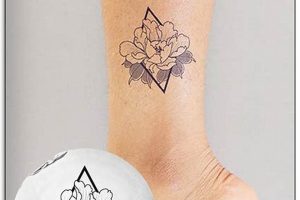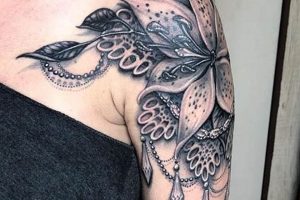Small, intricate designs, symbolic imagery, and text-based art are popular choices for body art on the feet. Examples include floral motifs, minimalist line drawings, meaningful quotes, or representations of personal beliefs. The placement allows for a discreet display or a bold statement depending on footwear choices.
Decorating the feet with permanent ink allows for self-expression and personalization. This body area offers a unique canvas for showcasing meaningful designs in a way that can be easily concealed or revealed. Historically, foot adornment has held cultural significance in various societies, and contemporary body ink continues this tradition in a modern form. The relatively small and contoured surface of the foot presents both creative challenges and opportunities for skilled artists.
Factors to consider include design suitability for the foot’s anatomy, pain tolerance, aftercare requirements, and the potential impact on footwear choices. Exploration of different styles, artistic consultations, and careful planning are essential for a successful outcome. Further discussion will delve into popular design themes, practical advice, and important considerations before committing to permanent artwork on the feet.
1. Placement
Strategic placement is paramount when considering artwork on the feet. The foot’s unique anatomy and constant interaction with footwear necessitate careful consideration of design location to maximize visual impact, comfort, and longevity.
- Top of Foot
This area offers a larger, relatively flat canvas, accommodating more complex designs. Visibility depends on footwear choices, allowing for discreet display or prominent showcasing. Examples include mandalas, floral patterns, or script extending from the ankle.
- Side of Foot
This placement offers a discreet option, often hidden by shoes. Delicate designs, such as small floral motifs, vines, or names, work well in this area. The curved surface presents a design challenge, requiring careful consideration of the foot’s natural contours.
- Sole of the Foot
This unconventional choice offers maximum concealment. However, the constant friction and contact with surfaces can lead to faster ink fading and require specific aftercare considerations. Simple, bold designs tend to hold up best in this location.
- Ankle and Heel
These areas provide a seamless transition between the foot and leg, allowing for designs that flow visually. Ankle bracelets, geometric patterns, or small symbolic images are popular choices. Consideration should be given to potential friction from footwear, particularly around the heel.
Careful selection of placement ensures the chosen design complements the foot’s anatomy and aligns with individual preferences for visibility and practicality. Ultimately, the most suitable placement contributes significantly to the overall success and satisfaction of the artwork.
2. Size and Scale
Size and scale are critical factors in successful foot artwork. The foot’s relatively small and contoured surface presents unique challenges and opportunities. A design too large can appear cluttered and overwhelm the foot’s natural shape, while a design too small may lack detail or become illegible over time. Proportionality to the chosen placement areatop of the foot, ankle, side, or soleis essential. A sprawling design intended for the top of the foot would be inappropriate for the side, for instance. Likewise, intricate details in a miniature design intended for the sole might quickly lose clarity due to regular wear and tear.
Consider a delicate floral vine encircling the ankle. This design works well because its scale complements the ankle’s slenderness. Conversely, a large portrait on the side of the foot might appear disproportionate and aesthetically unbalanced. Practical considerations also come into play. Larger designs require longer sessions and potentially multiple appointments, impacting both cost and healing time. Smaller designs, while quicker to execute, require careful consideration of line thickness and detail to ensure longevity. For example, fine lines on the sole of the foot are prone to fading more rapidly than bolder lines due to friction.
Appropriate size and scale ensure design integrity and longevity. Careful consideration of these elements enhances aesthetic appeal and contributes to the overall success of the artwork. Balancing design aspirations with the foot’s anatomical constraints and the practicalities of wear and tear is essential for achieving a visually pleasing and enduring result. Consultation with a skilled artist is crucial for determining the optimal size and scale, ensuring the design complements the foot’s unique characteristics and aligns with individual preferences.
3. Style and Imagery
Style and imagery are integral to realizing compelling foot artwork. Individual expression finds form through diverse artistic styles, symbolic representation, and meaningful imagery. Careful consideration of these elements ensures a cohesive and personalized design that resonates with the wearer’s aesthetic and personal narrative.
- Minimalism
Characterized by clean lines, geometric shapes, and negative space, minimalism offers a contemporary aesthetic. Small, uncluttered designs, such as outlines of objects, geometric patterns, or single words, work well on the foot’s limited canvas. This style prioritizes simplicity and impactful visuals, offering a timeless and subtle form of expression.
- Watercolor
Mimicking the fluidity and vibrancy of watercolor paintings, this style uses soft color gradients and diffused lines. Floral designs, abstract patterns, and depictions of animals or landscapes lend themselves well to this expressive approach. The delicate nature of watercolor tattoos requires careful consideration of placement and sun exposure to maintain vibrancy.
- Realism
Focusing on detailed and lifelike representation, realism captures intricate details and textures. Portraits of loved ones, depictions of animals, or intricate floral arrangements are common examples. This style demands technical skill and careful consideration of the foot’s contours to achieve a convincing three-dimensional effect.
- Symbolic Imagery
Symbolic imagery imbues designs with personal meaning and cultural significance. Religious symbols, astrological signs, or elements from nature can convey beliefs, values, or personal experiences. Careful research and understanding of symbolic meanings are essential for ensuring accurate and respectful representation.
Harmonizing style and imagery with placement, size, and scale creates a unified and aesthetically pleasing composition. Individual preference, cultural background, and personal narrative play significant roles in selecting the appropriate style and imagery. Consulting with skilled artists ensures design choices align with the wearer’s vision and the foot’s unique anatomical constraints, resulting in a personalized and meaningful piece of art.
4. Pain Management
Pain management is a crucial aspect of the foot tattooing process. The foot’s sensitivity, due to its thin skin and proximity to bone, makes pain a significant consideration. Effective pain management strategies contribute to a more comfortable experience, allowing for greater focus and precision during the procedure. Ignoring pain management can lead to involuntary movements, potentially compromising the artist’s work and increasing the risk of complications. For example, a sudden flinch due to unexpected pain could result in an unintended line or an uneven application of ink.
Several methods can mitigate discomfort. Topical anesthetic creams, applied prior to the procedure, numb the skin’s surface. Over-the-counter pain relievers, such as ibuprofen, can reduce inflammation and manage general discomfort. Proper breathing techniques and relaxation exercises can also help manage pain perception. Experienced artists skilled in working on sensitive areas understand the importance of breaks and pacing the session to minimize discomfort. A skilled artist might choose to work in shorter bursts, focusing on less sensitive areas first, to allow for periods of reduced intensity. Communicating openly with the artist regarding pain levels throughout the session is crucial. This allows the artist to adjust techniques or provide breaks as needed.
Pain tolerance varies significantly among individuals. Factors influencing pain perception include individual sensitivity, the tattoo’s size and complexity, and the chosen location on the foot. The sole, for instance, is generally considered more painful than the top of the foot. Understanding individual pain thresholds and employing appropriate management strategies is vital for a positive tattooing experience. Effective pain management allows individuals to focus on the artistic process rather than the discomfort, contributing to a successful outcome. It ensures greater comfort, reduces the risk of complications arising from involuntary movements, and ultimately enhances satisfaction with the final artwork.
5. Aftercare Practices
Appropriate aftercare is essential for preserving the vibrancy and longevity of foot artwork. Diligent adherence to recommended practices minimizes the risk of infection, promotes proper healing, and ensures the tattooed design retains its intended appearance over time. Neglecting aftercare can lead to complications such as infection, fading, or blurring of the design, compromising the aesthetic outcome and potentially posing health risks. Given the foot’s constant contact with footwear and exposure to various environmental factors, meticulous aftercare is particularly critical for foot tattoos.
- Washing and Moisturizing
Regularly washing the tattoo with a mild, fragrance-free soap removes excess ink, plasma, and potential irritants. Gentle patting with a clean towel, avoiding rubbing, minimizes disruption to the healing skin. Applying a thin layer of fragrance-free, alcohol-free moisturizer keeps the skin hydrated, preventing scabbing and promoting healthy cell regeneration. Over-moisturizing, however, can create an environment conducive to bacterial growth, so a balanced approach is essential.
- Protection and Sun Exposure
Protecting the tattoo from friction caused by footwear and socks is crucial during the healing process. Loose-fitting, breathable footwear minimizes irritation and allows for adequate air circulation. Direct sunlight can fade tattoo ink, particularly during the initial healing phase. Sunscreen with a high SPF should be applied once the tattoo is fully healed to protect the design’s vibrancy long-term.
- Avoiding Soaking and Swimming
Prolonged soaking in water, such as baths, hot tubs, or swimming pools, should be avoided during the healing period. Excessive moisture can soften the skin, increasing the risk of infection and ink loss. Short showers are permissible, but the tattooed area should be patted dry immediately afterward. Exposure to potentially contaminated water sources increases the risk of introducing bacteria to the healing wound.
- Recognizing Infection Signs
Monitoring the tattoo for signs of infection is crucial. Redness, excessive swelling, persistent pain, or the presence of pus warrant immediate medical attention. Early intervention can prevent complications and ensure proper healing. Ignoring infection signs can lead to serious health issues and permanent damage to the tattoo. Consulting a healthcare professional at the first sign of infection is essential.
Consistent and meticulous aftercare practices are integral to the long-term success of foot artwork. These practices, ranging from proper hygiene and sun protection to recognizing infection signs, directly influence the healing process, color retention, and overall aesthetic outcome. Adhering to these guidelines ensures the tattooed design remains vibrant and visually appealing, reflecting the initial artistic vision and minimizing potential health risks. Ultimately, dedicated aftercare preserves the integrity of the artwork and contributes to long-term satisfaction with the chosen foot tattoo design.
Tips for Foot Tattoos
Careful planning ensures successful execution and long-term satisfaction with foot artwork. Consideration of practical aspects, alongside aesthetic preferences, contributes to a positive outcome and a design that endures beautifully over time.
Tip 1: Consult a reputable artist specializing in fine-line or small-scale designs.
The foot’s intricate contours and limited surface area necessitate an artist skilled in executing precise details on a challenging canvas. Experienced artists possess the technical expertise to adapt designs effectively to the foot’s unique shape and can advise on placement, size, and style.
Tip 2: Evaluate pain tolerance and consider pain management options.
The foot’s sensitivity requires careful consideration of pain management strategies. Discuss options like topical anesthetics with the chosen artist to ensure a more comfortable experience.
Tip 3: Prioritize designs suitable for the foot’s anatomy and movement.
Designs that complement the foot’s natural curves and accommodate flexion and movement tend to age more gracefully. Avoid overly intricate details in high-friction areas like the sole or heel.
Tip 4: Factor in lifestyle and footwear choices.
Consider how frequently footwear will conceal the tattoo and how certain shoe styles might rub against the design, potentially impacting its longevity. Open-toed shoes or sandals, for example, might expose a design to more sunlight and potential fading.
Tip 5: Prepare for extended healing times and specific aftercare requirements.
Foot tattoos often require more extended healing periods than other body areas due to their location and frequent contact with footwear. Diligent aftercare, including moisturizing and sun protection, is essential for optimal healing and color retention.
Tip 6: Research symbolism and cultural significance thoroughly.
If opting for symbolic imagery, ensure a comprehensive understanding of its meaning and cultural context to avoid misinterpretations or unintentional offense. Consult resources specializing in cultural symbolism or discuss concerns with the chosen artist.
Tip 7: View the design from various angles and perspectives.
Given the foot’s three-dimensional form, visualize how the design will appear from different angles and in motion. This ensures the design remains aesthetically pleasing regardless of foot position or movement.
Careful consideration of these tips ensures informed decisions, maximizes aesthetic impact, and promotes successful healing, contributing to a lasting and visually appealing piece of body art.
By understanding the unique challenges and opportunities presented by foot artwork, individuals can make informed choices that align with their aesthetic vision and lifestyle. This preparation paves the way for a positive tattooing experience and a piece of art that remains meaningful and visually stunning for years to come.
Frequently Asked Questions
Addressing common inquiries regarding foot tattoos provides clarity and facilitates informed decision-making. Understanding potential challenges, aftercare requirements, and practical considerations empowers individuals to approach the process with realistic expectations.
Question 1: How painful are foot tattoos compared to other body areas?
Pain levels vary due to individual tolerances and the specific location on the foot. Generally, the foot’s thin skin and proximity to bone contribute to increased sensitivity compared to fleshier areas. The sole is often cited as the most painful area.
Question 2: How long do foot tattoos typically take to heal?
Healing times often extend beyond those of other placements due to frequent contact with footwear and the foot’s constant movement. Complete healing may require four to six weeks, sometimes longer depending on individual factors and design complexity.
Question 3: Do foot tattoos fade faster than tattoos in other locations?
Increased friction from footwear and exposure to environmental factors can contribute to faster fading, particularly on the sole. Diligent sun protection and proper aftercare mitigate this effect.
Question 4: What design elements are best suited for the foot’s unique anatomy?
Smaller, simpler designs often adapt best to the foot’s limited space and contours. Flowing lines and designs that complement the foot’s natural shape tend to age more gracefully than large, intricate pieces.
Question 5: What special aftercare considerations are necessary for foot tattoos?
Keeping the tattoo clean and moisturized, avoiding tight-fitting footwear during healing, and diligently protecting the area from sun exposure are crucial for optimal healing and color retention.
Question 6: How does footwear affect a foot tattoo during and after healing?
Tight or restrictive footwear can impede healing by causing friction and irritation. Open shoes expose the tattoo to potential sun damage. Choosing appropriate footwear both during and after healing is vital for protecting the design and promoting proper recovery.
Careful consideration of these frequently asked questions, combined with consultation with a reputable artist, facilitates informed decisions and minimizes potential complications. Thorough preparation and realistic expectations are essential for a positive tattooing experience and a design that endures beautifully over time.
Further exploration of design galleries and consultations with experienced artists provide deeper insights and personalized guidance.
Foot Tattoo Ideas
Exploration of permanent artwork on the feet necessitates careful consideration of placement, size, style, and aftercare. Design choices should complement the foot’s anatomy and individual preferences, balancing aesthetic appeal with practical implications. Pain management and diligent aftercare are crucial for successful healing and long-term design integrity. Informed decision-making ensures a positive experience and a visually appealing result that endures.
Permanent body art represents a significant commitment. Thorough research, consultation with experienced professionals, and realistic expectations are essential for achieving desired outcomes and minimizing potential complications. Ultimately, informed choices empower individuals to express personal narratives through aesthetically pleasing and enduring artwork on the feet.







